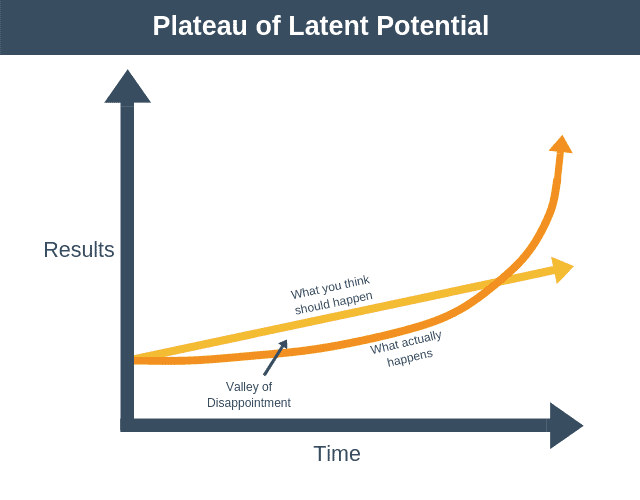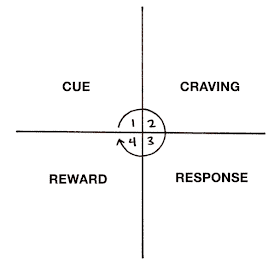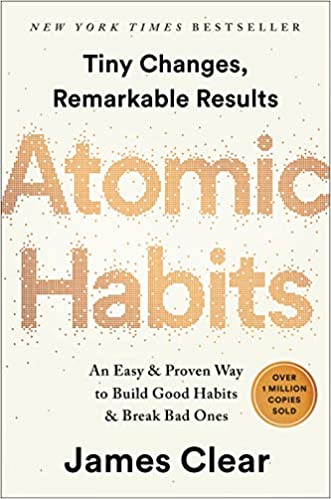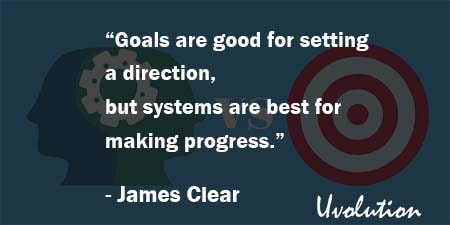Atomic Habits by James Clear Summary
The Book in 1 Sentences
Atomic Habits: An Easy & Proven Way to Build Good Habits & Break Bad Ones
“Making a choice that is 1 percent better or 1 percent worse seems insignificant in the moment, but over the span of moments that make up a lifetime these choices determine the difference between who you are and who you could be. Success is the product of daily habits- -not once-in-a-lifetime transformations.” ~ James Clear
5 BIG Ideas
1. What starts as a small win or a minor setback accumulates into something much more.
2. “Ultimately, it is your commitment to the process that will determine your progress.”
3. Habits are not about having something. They are about becoming someone.
4. “The Four Laws of Behavior Change are a simple set of rules we can use to build better habits. They are (1) make it obvious, (2) make it attractive, (3) make it easy, and (4) make it satisfying.”
5. “The holy grail of habit change is not a single 1 percent improvement but a thousand of them.”
Atomic Habits Book Summary
1. What are the Atomic Habits?
“If you’re having trouble changing your habits, the problem isn’t you. The problem is your system. Bad habits repeat themselves again and again not because you don’t want to change, but because you have the wrong system for change.
You do not rise to the level of your goals. You fall to the level of your systems. Focusing on the overall system, rather than a single goal, is one of the core themes of this book.
It is also one of the deeper meanings behind the word atomic. By now, you’ve probably realized than an atomic habit refers to a tiny change, a marginal gain, a 1 percent improvement. But atomic habits are not just any old habits, however small. They are little habits that are part of a larger system.
Just as atoms are the building blocks of molecules, atomic habits are the building blocks of remarkable results. Habits are like the atoms of our lives. Each one is a fundamental unit that contributes to your overall improvement.
At first, these tiny routines seem insignificant, but soon they build on each other and fuel bigger wins that multiply to a degree that far outweighs the cost of their initial investment.
They are both small and mighty. This is the meaning of the phrase atomic habits—a regular practice or routine that is not only small and easy to do, but also the source of incredible power; a component of the system of compound growth.”
2. The Effect of 1%
“It is so easy to overestimate the importance of one defining moment and underestimate the value of making small improvements on a daily basis.
Too often, we convince ourselves that massive success requires massive action. Whether it is losing weight, building a business, writing a book, winning a championship, or achieving any other goal, we put pressure on ourselves to make some earth-shattering improvement that everyone will talk about.
Meanwhile, improving 1 percent isn’t particularly notable—sometimes it isn’t even noticeable—but it can be far more meaningful, especially in the long run.
The difference a tiny improvement can make over time is astounding. Here’s how the math works out: if you can get 1 percent better each day for one year, you’ll end up thirty-seven times better by the time you’re done.
Conversely, if you get 1 percent worse each day for one year, you’ll decline nearly down to zero.
What starts as a small win or a minor setback accumulates into something much more.
Habits are the compound interest of self-improvement. The same way that money multiplies through compound interest, the effects of your habits multiply as you repeat them.
They seem to make little difference on any given day and yet the impact they deliver over the months and years can be enormous.
It is only when looking back two, five, or perhaps ten years later that the value of good habits and the cost of bad ones becomes strikingly apparent.”
“You should be more concerned with your current trajectory than with your current results. ... If you want to predict where you’ll end up in life, all you have to do is follow the curve of tiny gains or tiny losses, and see how your daily choices will compound ten or twenty years down the line.”
Imagine a plane taking off from LAX. The desired destination is New York City. But if the nose of the plane is pointed just 3.5 degrees south and the pilots don’t correct for it, they’ll land in Washington D.C. rather than NYC. 90 inches off at the start equals hundreds of miles off at the end.
So, remember that little things matter.
3. The Plateau of Latent Potential

“If you find yourself struggling to build a good habit or break a bad one, it is not because you have lost your ability to improve. It is often because you have not yet crossed the Plateau of Latent Potential.
Complaining about not achieving success despite working hard is like complaining about an ice cube not melting when you heated it from twenty-five to thirty-one degrees.
Your work was not wasted; it is just being stored. All the action happens at thirty-two degrees. When you finally break through the Plateau of Latent Potential, people will call it an overnight success. ...
Mastery requires patience. The San Antonio Spurs, one of the most successful teams in NBA history, have a quote from social reformer Jacob Riis hanging in their locker room:
‘When nothing seems to help, I go and look at a stonecutter hammering away at his rock, perhaps a hundred times without as much as a crack showing in it. Yet at the hundred and first blow it will split in two, and I know it was not that last blow that did it—but all that had gone before.’”
Little things add up to big things. But you should know that it takes time – to cross what James calls the Plateau of Latent Potential- for those little things to add up to those big things.
“The purpose of setting goals is to win the game. The purpose of building systems is to continue playing the game. True long-term thinking is goal-less thinking.
It’s not about any single accomplishment. It is about the cycle of endless refinement to continuous improvement. Ultimately, it is your commitment to the process that will determine your progress.”
4. Identity Change
“Identity change is the North Star of habit change. The remainder of this book will provide you with step-by-step instructions on how to build better habits for yourself, your family, your team, your company, and anywhere else you wish.
But the true question is: ‘Are you becoming the type of person you want to become?’ The first step is not what or how, but who. You need to know who you want to be. Otherwise, your quest for change is like a boat without a rudder. And that’s why we’re starting here.
You have the power to change your beliefs about yourself. Your identity is not set in stone. You have a choice in every moment. You can choose the identity you want to reinforce today with habits you choose today.
And this brings us to the deeper purpose of this book and the real reason habits matter.
Building better habits isn’t about littering your day with life hacks. It’s not about flossing one tooth each night or taking a cold shower each morning or wearing the same outfit each day.
It’s not about achieving external measures of success like earning more money, losing weight, or reducing stress. Habits can help you achieve all of these things, but fundamentally they are not about having something. They are about becoming someone.
Ultimately, your habits matter because they help you become the type of person you wish to be. They are the channel through which you develop your deepest beliefs about yourself. Quite literally, you become your habits.”
So, ask yourself… WHO do you want to be?
Identify that, then go do whatever it takes to become that person! “you become your habits”.
“The more you repeat a behavior, the more you reinforce the identity associated with that behavior. In fact, the word identity was originally derived from the Latin word essentitas, which means being, and identidem, which means repeatedly. Your identity is literally your “repeated beingness.’”
5. How to Build Better Habits in 4 Simple Steps
“If a behavior is insufficient in any of the four stages, it will not become a habit. Eliminate the cue and your habit will never start. Reduce the craving and you won’t experience enough motivation to act.
Make the behavior difficult and you won’t be able to do it. And if the reward fails to satisfy your desire, then you’ll have no reason to do it again in the future.
Without the first three steps, a behavior will not occur. Without all four, a behavior will not be repeated.
In summary, the cue triggers a craving, which motivates a response, which provides a reward, which satisfies the craving and, ultimately, becomes associated with the cue.
Together, these four steps form a neurological feedback loop—cue, craving, response, reward; cue, craving, response, reward—that ultimately allows you to create automatic habits. This cycle is known as the habit loop.”

“Whether we are approaching behavior change as an individual, a parent, a coach, or a leader, we should ask ourselves the same question: ‘How can we design a world where it’s easy to do what’s right?’ Redesign your life so the actions that matter most are also the actions that are easiest to do.”
“The Four Laws of Behavior Change are a simple set of rules we can use to build better habits. They are (1) make it obvious, (2) make it attractive, (3) make it easy, and (4) make it satisfying.”

And here is an advice: “One of the most effective things you can do to build better habits is to join a culture where your desired behavior is the normal behavior. ... Your culture sets your expectation for what is ‘normal.’ Surround yourself with people who have the habits you want to have yourself. You’ll rise together.”
6. The Sorites Paradox
“There is an ancient Greek parable known as the Sorites Paradox, which talks about the effect one small action can have when repeated enough times.
One formulation of the paradox goes as follows: Can one coin make a person rich? If you give a person a pile of ten coins, you wouldn’t claim that he or she is rich. But what if you add another? And another? And another? At some point, you will have to admit that no one can be rich unless one coin can make him or her so.
We can say the same thing about habits. Can one tiny change transform your life? It’s unlikely you would say so. But what if you made another? And another? And another? At some point, you will have to admit that your life was transformed by one small change.
The holy grail of habit change is not a single 1 percent improvement but a thousand of them. It’s a bunch of atomic habits stacking up, each one a fundamental unit of the overall system. ...
The secret of getting results that last is to never stop making improvements. It’s remarkable what you can build if you just don’t stop. ... Small habits don’t add up. They compound. That’s the power of atomic habits. Tiny changes. Remarkable results.”
“The only way to become excellent is to be endlessly fascinated by doing the same thing over and over. You have to fall in love with boredom.”
That was my QUICK Atomic Habits book summary. If you’re interested, get your copy. There is a HUGE amount of wisdom and life-changing ideas in this book, and we’ve only touched on a tiny bit of it.
Buy The Book: Atomic Habits by James Clear

GET Blinkist 7 Days FREE Trial
3000+ Book Summaries
(Audio and Text)





